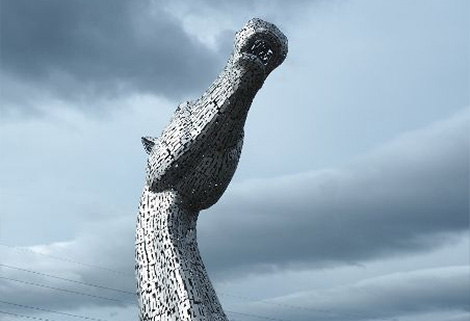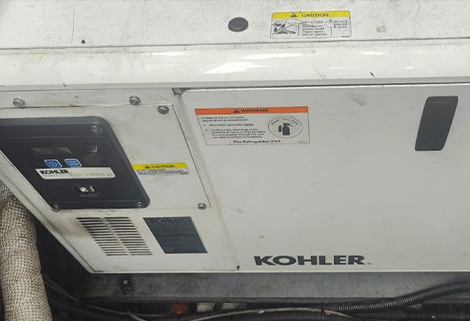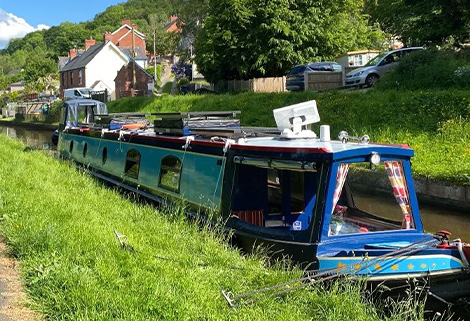bournville 5
horse drawn barge carrying milk for cadbury's chocolate
(first published in 1996, but re-published here with the kind permission of Richard Hill)
Richard Hill tells the story of his grandfather, George Wiseman whose job was operating the horse-drawn boat Bournville 5 carrying milk to the busy Cadbury processing plant in Knighton on the Shropshire Union Canal a hundred years ago in the 1920s.
Anyone who's cruised the Shroppie between Bridge 45 and the Shebdon Embankment through Staffordshire will have come across a deserted canopy, its castellated fringe reaching out of the trees on the north bank. Approaching from the east, boat owners will have noticed a large glazed industrial plant concealed behind. Approached from the west and the canopy remains hidden by trees until reached, but the rising industrial noise may give a hint of something up ahead. This was part of the Premier Beverage plant, accessible only by road. In the 1920s however, this was the busy processing plant of Cadbury Limited. Milk was collected from local farms along the Shroppie and brought to this plant for processing into crumb chocolate which was then taken by canal to the Cadbury Bournville factory for further refinement into the world-famous Cadbury's chocolate.

One of the boatmen working on the canal from here was my grandfather, George Wiseman. After serving in World War One he went back to his old job of collecting milk for a cheese processing plant in Gnosall from local farms by horse-drawn narrowboat. The wages were not good. When an opening for similar work became available at the Cadbury Knighton factory, George applied. The terms offered by Cadbury were much better and George was taken on. George and his wife Evelyn lived in Norbury with their family, two sons Henry and Bernard and daughters Joyce, Dorothy, Janet, and Elizabeth.
A short walk across the field started George's working day at Norbury Junction where the horse was stabled and the boat Bournville 5 moored. Work started at 6 a.m. The horse was groomed, tackled and prepared to haul the boat load of 150 empty milk turns to the start of the collection at High Onn (bridge 25). Churns full of milk were left by the milk farmers at High Onn wharf and collecting points along the canal. Gradually, as the boat made progress towards Knighton, churns, each one labelled by the farmer, were loaded onto the boat, and empty churns deposited for the following days collection. Once the boat arrived at the Cadbury Knighton plant the full churns were unloaded, the quantity and quality of each checked before being emptied and processed. It was these checks that would determine the payment to be made to each farmer each month. The empty churns remained inverted for cleaning before passing on to a conveyor that would carry them up to the top of a storage tower. The churns were stacked on the helical track, gravity carrying them back down to the bottom for redistribution, a sort of giant ‘helter skelter’ for empty milk churns. Once empty the boat was reloaded with empty churns from the bottom of the tower in preparation for the following days collection. George the boat and horse returned to Norbury Junction. The horse was stabled, the boat moored and George finished for the day usually around three to four pm.

In 1925 at the age of six George's eldest daughter Joyce had scarlet fever. George could not live at home for the period while the virus was contagious for fear of carrying it to the other families. He went to live at ‘The Junction Pub’ at Norbury Junction which was run by his father and mother, Henry and Mary Wiseman. Today this is a busy pub and restaurant but then it was a small pub on a small farm holding of 14 acres.
One of the perks of Cadbury employees was being able to buy cheap chocolate particularly when it was rationed during the Second World War. Employees could make a monthly purchase of three or four 2-pound bags of misshapen chocolate, each bar bag marked ‘Not for Resale’ and costing George about one shilling a bag.
Another purchasable product was ‘crumb’ chocolate, the product of the factory made from cocoa beans, sugar and milk. This was sent to the Bournville factory, by motorised narrowboat, for final processing into chocolate bars. George's son Bernard recalled the crumb chocolate as an occasional treat: “It looked like sandstone but tasted lovely.”
Each summer Cadbury would host a summer fete for the children of their employees on the field high on the bank opposite the factory. Between egg and spoon or sack races the children would look down and wave to their fathers working at the plant. The highlight of the day was a trip on the canal in one of the horse-drawn narrow boats.

The milk collecting routine continued daily through each season. The canal was a vital part of the dairyland community. In winter an ice breaking boat would clear the canal for the daily working traffic but in the winter of 1929 even the icebreaker was outdone by the weather and the milk had to be collected by road. Perhaps Cadbury recognized the opportunity as a more efficient form of transport or perhaps for other reasons, the milk collection was slowly transferred from canal to road.
Following Bournville 5’s final collection, George was transferred to work at the plant itself, loading and unloading lorries with milk chocolate crumb and other imports and exports from the factory. By now George lived in Knightley some eight miles from the factory. In the 30 or so years of working a country he was late for work only once. On the 12th of February 1955 while motorcycling to work he collapsed and died having suffered a heart attack. George enjoyed his work and died probably the way he would want. His children, now all sadly passed themselves, remembered him as a fine man, Cadbury as a good employer and a manufacturer of fine chocolate, so much so that my mother Dorothy, never bought chocolate other than that made by Cadbury.









